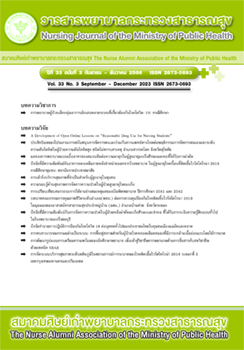Rehabilitative Massage for Stroke Patients with Muscle Weakness: A Systematic Review
Main Article Content
Abstract
This study was a systematic literature review to investigate the effect of massage on stroke patients with muscle weakness. Experimental and quasi-experimental quantitative research papers published in Thai and English in Google Scholar, ThaiJo, PubMed, CINAHL, Medline Complete, and Cochrane Library databases from 2012–2022 were selected using a research screening tool developed by the researcher. A critical appraisal of experimental research or quasi-experimental research from the Joanna Briggs Institute was performed. Data extraction consisted of 2 parts, with Part 1 comprising general information about the research, and Part 2 comprising the content of the research. The second co-author of the study read the report independently and completed the data summary form. This systematic review found seven eligible articles on experimental and quasi-experimental studies concerning the effects of massage on stroke patients with muscle weakness, conducted both in Thailand (3 articles) and abroad (4 articles). The sample size was 50-444 people. There were 5 massage styles, including thick massage, touch massage, royal Thai massage and Indian massage. The results showed that massage reduced muscle spasms in patients with stroke, improved the function and sensation of nerve endings, and increased the ability to perform daily activities. Thus, it can be concluded that massage can be used in the rehabilitation of stroke patients.
Article Details

This work is licensed under a Creative Commons Attribution-NonCommercial-NoDerivatives 4.0 International License.
บทความและรายงานวิจัยในวารสารพยาบาลกระทรวงสาธารณสุข เป็นความคิดเห็นของ ผู้เขียน มิใช่ของคณะผู้จัดทำ และมิใช่ความรับผิดชอบของสมาคมศิษย์เก่าพยาบาลกระทรวงสาธารณสุข ซึ่งสามารถนำไปอ้างอิงได้
References
Feigin VL, Brainin M, Norrving B, Martins S, Sacco RL, Hacke W, et al. World Stroke Organization (WSO): Global Stroke Fact Sheet 2022. International Journal Stroke 2022;17(1):18-29.
Strategy and Planning Division Ministry of Public Health. Public Health Statistic A.D.2021. Nonthaburi: Strategy and Planning Division;2022.(in Thai)
Luengo-Fernandez R, Violato M, Candio P, Leal J. Economic burden of stroke across Europe: A population-based cost analysis. European Stroke Journal 2020;5(1): 17-25.
Ma Z, Deng G, Meng Z, Wu H. Hospitalization expenditures and out-of-pocket expenses in patients with stroke in Northeast China, 2015-2017: A pooled cross-sectional study. Frontiers in Pharmacology 2021;11: 1-11.
Ramos-Lima MJM, Brasileiro IC, Lima TL, Braga-Neto P. Quality of life after stroke: impact of clinical and sociodemographic factors. Clinics 2018;43 e418:1-7.
Rudberg A, Berge E, Laska A, Jutterström S, Näsman P, Sunnerhagen KS, Lundström E. Stroke survivors’ priorities for research related to life after stroke. Stroke Rehabilitation 2021,28(2): 153-8.
Tochaiwat K, Predeekanit K, Udom T, Srisubat A, Thaiyaku A. Massage therapy for spastic neurological patients: A systematic review. Journal of the Department of Medical Services 2019; 44(1):42-6.(in Thai)
Korjedee P, Wongtao C, Maungthaitut P. The effect of Thai massage on Activities of Daily Living, Anxiety and Depress in stroke patients. Journal of Nursing Science & Health 2019; 42(2):106-14.
Thanakiatpinyo T, Suwannatrai S, Suwannatrai U, Khumkaew P, Wiwattamongkol D, Vannabhum M, et al. The efficacy of traditional Thai massage in decreasing spasticity in elderly stroke patients. Clin Interv Aging 2014;9:1311-9.
Chartsuwan J, Peanpadungrat P, Itharat A, Panichakarn N. Comparative study on efficacy of physiotherapy and physiotherapy combined with Thai massage on rehabilitation outcome and quality of life of ischemic stroke patients with hemiplegia. Thamasat Medical Journal 2017;17(3): 356-64.
Dedkhard S. (2015) Effects of rehabilitation program using complementary therapy in stroke patients. Journal of Prapokklao Hospital Clinical Medical Center 2015;32(2):135-46.(in Thai)
Rohmah IK, Pujiastuti RSE, Rumahorbo H. The effectiveness massage therapy on motoric status among non-hemorrhagic stroke patients. International Journal of Nursing and Health Services 2021;4(5): 575-83.
The Joanna Briggs Institute. Critical Apprisal Tool 2020. Available from https://jbi.global/critical-appraisal-tools (accessed 25 June 2021).
Yang Y-J, Zhang J, Hou Y, Jiang B-Y, Pan H-F, Wang J, et al. Effectiveness and safety of Chinese massage therapy (Tui Na) on post-stroke spasticity: A prospective multicenter randomized controlled trial. Clinical Rehabilitation 2017; 31: 904–12.
Lämås K, Häger C, Lindgren L, Wester P, Brulin C. Does touch massage facilitate recovery after stroke? A study protocol of a randomized controlled trial. BMC Complementary and Alternative Medicine 2016:1-9.
Chanachai W. Effectiveness and safety of royal massage in the rehabilitation of patients with subacute ischemic stroke in the Public Health Service Unit, Yasothon Province. Suppasit Medical Journal 2022;43(1):13-20.(in Thai)
Wang M, Liu S, Peng Z, Zhu Y, Feng X, Gu Y, et al. Effect of Tui Na on upper limb spasticity after stroke: a randomized clinical trial. Annals of Clinical and Translational Neurology 2019;6(4): 778–787.
Zarnigar & Rahaman A. Role of dalak(massage) and riyazat (exercise) in the rehabilitation of patients with post stroke hemiplegia. India Journal of Traditional Knowledge 2012;11(4):738-44.
Buttagat V, Eungpinichpong W, Chatchawan U, Arayawichanon P. Journal of Bodywork & Movement Therapies 2012;16:57-63.
Sankaran R, Kamath R, Nambiar V, Kuar A. A prospective study on the effects of Ayurvedic massage in post-stroke patients. Journal of Ayurveda and Integrative Medicine 2019;10:126-30.

